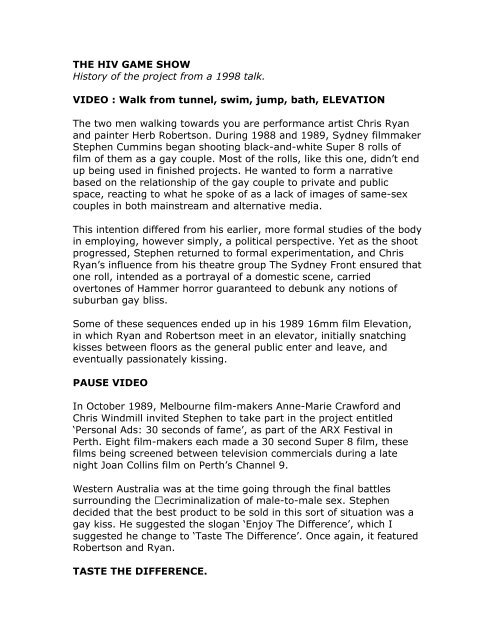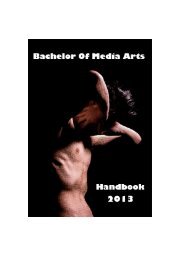THE HIV GAME SHOW History of the project from a ... - COFA Sites
THE HIV GAME SHOW History of the project from a ... - COFA Sites
THE HIV GAME SHOW History of the project from a ... - COFA Sites
Create successful ePaper yourself
Turn your PDF publications into a flip-book with our unique Google optimized e-Paper software.
<strong>THE</strong> <strong>HIV</strong> <strong>GAME</strong> <strong>SHOW</strong><br />
<strong>History</strong> <strong>of</strong> <strong>the</strong> <strong>project</strong> <strong>from</strong> a 1998 talk.<br />
VIDEO : Walk <strong>from</strong> tunnel, swim, jump, bath, ELEVATION<br />
The two men walking towards you are performance artist Chris Ryan<br />
and painter Herb Robertson. During 1988 and 1989, Sydney filmmaker<br />
Stephen Cummins began shooting black-and-white Super 8 rolls <strong>of</strong><br />
film <strong>of</strong> <strong>the</strong>m as a gay couple. Most <strong>of</strong> <strong>the</strong> rolls, like this one, didn’t end<br />
up being used in finished <strong>project</strong>s. He wanted to form a narrative<br />
based on <strong>the</strong> relationship <strong>of</strong> <strong>the</strong> gay couple to private and public<br />
space, reacting to what he spoke <strong>of</strong> as a lack <strong>of</strong> images <strong>of</strong> same-sex<br />
couples in both mainstream and alternative media.<br />
This intention differed <strong>from</strong> his earlier, more formal studies <strong>of</strong> <strong>the</strong> body<br />
in employing, however simply, a political perspective. Yet as <strong>the</strong> shoot<br />
progressed, Stephen returned to formal experimentation, and Chris<br />
Ryan’s influence <strong>from</strong> his <strong>the</strong>atre group The Sydney Front ensured that<br />
one roll, intended as a portrayal <strong>of</strong> a domestic scene, carried<br />
overtones <strong>of</strong> Hammer horror guaranteed to debunk any notions <strong>of</strong><br />
suburban gay bliss.<br />
Some <strong>of</strong> <strong>the</strong>se sequences ended up in his 1989 16mm film Elevation,<br />
in which Ryan and Robertson meet in an elevator, initially snatching<br />
kisses between floors as <strong>the</strong> general public enter and leave, and<br />
eventually passionately kissing.<br />
PAUSE VIDEO<br />
In October 1989, Melbourne film-makers Anne-Marie Crawford and<br />
Chris Windmill invited Stephen to take part in <strong>the</strong> <strong>project</strong> entitled<br />
‘Personal Ads: 30 seconds <strong>of</strong> fame’, as part <strong>of</strong> <strong>the</strong> ARX Festival in<br />
Perth. Eight film-makers each made a 30 second Super 8 film, <strong>the</strong>se<br />
films being screened between television commercials during a late<br />
night Joan Collins film on Perth’s Channel 9.<br />
Western Australia was at <strong>the</strong> time going through <strong>the</strong> final battles<br />
surrounding <strong>the</strong> ecriminalization <strong>of</strong> male-to-male sex. Stephen<br />
decided that <strong>the</strong> best product to be sold in this sort <strong>of</strong> situation was a<br />
gay kiss. He suggested <strong>the</strong> slogan ‘Enjoy The Difference’, which I<br />
suggested he change to ‘Taste The Difference’. Once again, it featured<br />
Robertson and Ryan.<br />
TASTE <strong>THE</strong> DIFFERENCE.
FACTS, <strong>the</strong> federal advertising self-regulation body, passed TASTE <strong>THE</strong><br />
DIFFERENCE as being suitable for late night viewing, but Channel Nine<br />
station manager Les Downes saw things differently, banning <strong>the</strong> ad<br />
<strong>from</strong> broadcast. He said that <strong>the</strong> ban was imposed because <strong>of</strong> <strong>the</strong><br />
‘explicit nature’ <strong>of</strong> <strong>the</strong> kiss. ‘We were not discriminating’, he said, ‘even<br />
a man and a woman kissing in this way might have upset certain<br />
viewers.’ Written protests were made by <strong>the</strong> <strong>project</strong>’s curators; by<br />
Stephen; and by Perth gay groups, but <strong>the</strong> ad was not screened.<br />
On November 17 th , 1989, <strong>the</strong> SBS program Eat Carpet screened all<br />
eight <strong>of</strong> <strong>the</strong> Personal Ads, including Taste The Difference.<br />
Unfortunately <strong>the</strong>y miscued <strong>the</strong> videotapes, and Melbourne filmmaker<br />
Dirk de Bruyn and Stephen received <strong>the</strong> wrong introductions to <strong>the</strong>ir<br />
respective films, with <strong>the</strong> following result:<br />
Video : Eat Carpet: Annette Shun Wah mistake – Dirk de Bruyn<br />
film.<br />
(After summarizing <strong>the</strong> controversy over ‘Taste <strong>the</strong> Difference’, host<br />
Annette Sun-Wah introduced <strong>the</strong> video, but mistakenly played Dirk De<br />
Bruyn’s piece instead. It showed <strong>the</strong> shadow <strong>of</strong> a young boy playing<br />
‘totem tennis’, with a looped voiceover <strong>of</strong> ‘daddy daddy, look at me!’.<br />
Host Annette Shun-Wah corrected <strong>the</strong> mistake on <strong>the</strong> following week’s<br />
program. Dirk is apparently still hiding out <strong>from</strong> Franca Arena.<br />
* POSTER: <strong>of</strong> TTD <strong>from</strong> exhibition.<br />
The image re-appeared in 1991. Sydney artist Kaye Shumack used it<br />
as one <strong>of</strong> three street posters in <strong>the</strong> ‘Visibility Posters’ <strong>project</strong>,<br />
connected to <strong>the</strong> inaugural Word Of Mouth exhibition curated by<br />
Ka<strong>the</strong>rine Fargher. (<strong>SHOW</strong> POSTER)<br />
Over <strong>the</strong> next five years, Stephen continued to achieve success with<br />
films like our collaborative piece ‘Resonance’, focussing on anti-gay<br />
violence, and photographic exhibitions such as ‘Enthralled’ , focussing<br />
on images <strong>of</strong> censorship. On discovering that he was <strong>HIV</strong>-Positive, he<br />
began to research a documentary called ‘Status’, which examined<br />
issues around <strong>HIV</strong>/AIDS and disclosure.<br />
He became ill during <strong>the</strong> early stages <strong>of</strong> this <strong>project</strong> in 1994, and as<br />
his hospital stay leng<strong>the</strong>ned, <strong>the</strong> <strong>project</strong> was scaled down.<br />
At <strong>the</strong> same time, Sydney artist Lynette Wallworth was organising <strong>the</strong><br />
Big New <strong>Sites</strong> <strong>project</strong> in conjunction with <strong>the</strong> Performance Space,
Pearl & Dean Cinema Advertising and Village Roadshow film<br />
distributors. Similar in concept to <strong>the</strong> Personal Ads <strong>project</strong>, it involved<br />
twelve artists submitting four slides toge<strong>the</strong>r with a one-minute sound<br />
piece. Each <strong>of</strong> <strong>the</strong>se were screened during <strong>the</strong> slide ads prior to <strong>the</strong><br />
commencement <strong>of</strong> film programs at <strong>the</strong> Hoyts and Greater Union<br />
complexes in George St, with each artist’s piece being screened for<br />
one month.<br />
Stephen’s treatment for <strong>the</strong> <strong>project</strong> suggested that he would take<br />
ideas and images <strong>from</strong> <strong>the</strong> Status <strong>project</strong> and use <strong>the</strong>m in this<br />
context. During his last days before his death on August 23rd, 1994, it<br />
became clear that Status was not going to go beyond its initial<br />
development. He was, however, keen to plan future <strong>project</strong>s as, it<br />
seemed to me, a way <strong>of</strong> imagining a future. So I would talk with him<br />
about bringing a copy <strong>of</strong> <strong>the</strong> Photoshop program to his home<br />
computer, in order to develop <strong>the</strong> four slides at home. Unfortunately<br />
<strong>the</strong> rapid advance <strong>of</strong> his illness did not even permit this to happen.<br />
After his death, I was invited to take over his piece for <strong>the</strong> Big New<br />
<strong>Sites</strong> <strong>project</strong>. It became a matter <strong>of</strong> choosing which <strong>of</strong> <strong>the</strong> multiple<br />
issues <strong>from</strong> a one-hour documentary to condense down to one minute<br />
<strong>of</strong> sound and image. Mindful <strong>of</strong> <strong>the</strong> unusual mainstream exposure that<br />
<strong>the</strong> George St site <strong>of</strong>fered, I talked to many people at <strong>the</strong> organisation<br />
People Living With <strong>HIV</strong>/AIDS (PLWHA) about <strong>the</strong> issues involved. The<br />
result was a decision to focus on poverty, placebo testing and <strong>the</strong><br />
growing censorship <strong>of</strong> gay images in <strong>HIV</strong>/AIDS educational material.<br />
Visually, I used several <strong>of</strong> Stephen’s stills, including a reference to his<br />
previously censored image. Stylistically, I referenced a scene <strong>from</strong><br />
Status , in which information was given in <strong>the</strong> context <strong>of</strong> a TV game<br />
show. I named <strong>the</strong> piece The <strong>HIV</strong> Game Show, and hired<br />
pr<strong>of</strong>essional voiceover man Keith Scott to deliver <strong>the</strong> message.<br />
<strong>THE</strong> <strong>HIV</strong> <strong>GAME</strong> <strong>SHOW</strong><br />
(TEXT TO GO ALONGSIDE IMAGES: )<br />
IMAGE 1. (TEXT: "The <strong>HIV</strong> game show" )<br />
COMPERE<br />
Shut up and listen, it's <strong>the</strong> <strong>HIV</strong> game show!<br />
All contestants <strong>HIV</strong> Positive... Test your buzzers!<br />
(BUZZ sound effect)
COMPERE<br />
Question One - Why was this image banned <strong>from</strong> TV<br />
(BUZZ SFX)<br />
CONTESTANT<br />
Because it's 2 men kissing<br />
COMPERE<br />
No! <strong>the</strong>y said <strong>the</strong> kiss itself was too explicit!<br />
IMAGE 2. (TEXT: "All contestants chosen randomly" )<br />
COMPERE<br />
Question 2 - You get two hundred dollars pension, but spend three<br />
hundred on rent, food and those pricey pills and potions! How do you<br />
get by Time's up!<br />
CONTESTANTS<br />
I don't know.<br />
(MUSIC SWELL)<br />
COMPERE<br />
I don't know is <strong>the</strong> correct answer! You both move on to our<br />
experimental drug trial!<br />
IMAGE 3. (TEXT: " OR" )<br />
COMPERE<br />
Going for gold, now! If you wish to play on, you can be a human<br />
guinea pig on a dangerous unknown drug, or you can have <strong>the</strong> sugar<br />
placebo pill!<br />
CONTESTANTS<br />
I can't choose.<br />
(MUSIC SWELL)<br />
COMPERE<br />
You don't have a choice! We'll make it for you!<br />
IMAGE 4. (TEXT: Credits)<br />
CONTESTANT<br />
I've had enough <strong>of</strong> this game!
COMPERE<br />
But don't go away, <strong>the</strong>re's much much more!<br />
CONTESTANT<br />
I'll finish when I'm ready!<br />
COMPERE<br />
Let me just run <strong>the</strong> rules by you!<br />
CONTESTANT<br />
Well, <strong>the</strong>n we just change <strong>the</strong> rules.<br />
The screening was to take place in late 1995, but a new battle <strong>of</strong><br />
words and correspondence began.<br />
28th September 1995: A letter <strong>from</strong> Carmen Cavell, production<br />
manager at Pearl & Dean Cinema Advertising explained that ‘<strong>the</strong><br />
material for slide advertising must be suitable for General Exhibition.<br />
Obviously, <strong>the</strong> contents <strong>of</strong> <strong>the</strong> <strong>HIV</strong> slides do not fall within <strong>the</strong>se<br />
guidelines.’<br />
We asked for specifics on <strong>the</strong>ir difficulties with <strong>the</strong> material.<br />
October 2nd, 1995: Letter <strong>from</strong> Grahame Garland, Director <strong>of</strong> Pearl &<br />
Dean: ‘The exhibitors are not prepared to screen any material that<br />
may <strong>of</strong>fend any segment <strong>of</strong> <strong>the</strong>ir audience.’<br />
Still no specifics. We requested a meeting, which was held on Monday,<br />
October 9th, 1995 at <strong>the</strong> <strong>of</strong>fices <strong>of</strong> Pearl and Dean. The following was<br />
said about <strong>the</strong> images.<br />
IMAGE 1: ‘We’d have trouble showing a man and a woman kissing like<br />
that’. The irony <strong>of</strong> <strong>the</strong> repeated reference to <strong>the</strong> original censorship<br />
was lost on <strong>the</strong> speaker.<br />
IMAGE 2: ‘There’s <strong>the</strong> nudity here, <strong>the</strong> buttocks’.<br />
IMAGE 3: ‘And this one, it’s two men in close proximity’.<br />
I <strong>the</strong>n presented my response, based on <strong>the</strong> idea that this blurry,<br />
distant, shadowed image was, indeed, a G-rated male-to-male kiss,<br />
and that <strong>the</strong> concept <strong>of</strong> a G-rated male-to-male kiss was permissible<br />
under <strong>the</strong> censorship guidelines, even though such a thing did not yet<br />
exist in actuality. This became a long campaign.
The guidelines provided by <strong>the</strong> OFLC at <strong>the</strong> time referred to levels <strong>of</strong><br />
Sexual References and Adult Themes against various ratings (G, PG, M<br />
an so on). They were defined as follows:<br />
SEXUAL REFERENCES may include verbal references to, and<br />
description and visual depictions <strong>of</strong>, sexual matters including Ñ double<br />
entendres, risque jokes and o<strong>the</strong>r sexual innuendo, torrid embraces,<br />
kisses and petting, partial nudity with sexual connotations.<br />
ADULT <strong>THE</strong>MES may include verbal references to, or description <strong>of</strong> and<br />
visuals associated with, elements such as Ñ suicide, crime, corruption,<br />
marital problems, divorce and o<strong>the</strong>r emotional trauma, drug and<br />
alcohol dependency, death and serious illness, racism, religious issues,<br />
homosexuality.<br />
Pick <strong>the</strong> odd one out. Nei<strong>the</strong>r Sexual References or Adult Themes were<br />
apparently permissible in G-rated films. I rang <strong>the</strong> OFLC secretary,<br />
Joel Greenberg and asked him how <strong>the</strong>y rated, say, a male-to-female<br />
kiss as opposed to a male-to-male kiss. He adamantly informed me<br />
that <strong>the</strong>re was no discriminatory practise in <strong>the</strong>ir ratings. Why <strong>the</strong>n, I<br />
asked, was homosexuality included in <strong>the</strong> Adult Themes list, when all<br />
sexual behavoir was adequately covered in <strong>the</strong> Sexual References list<br />
Was <strong>the</strong> mere existence <strong>of</strong> a homosexual character something that<br />
could cause distress to children His reply was : ‘I can’t comment on<br />
that’.<br />
I <strong>the</strong>n spoke to David Haines, who was Deputy Chief Censor <strong>from</strong> 1988<br />
to 1994, and who actually had written <strong>the</strong> guidelines that were <strong>the</strong>n in<br />
force. His replies were similar, except that he conceded that <strong>the</strong><br />
presence <strong>of</strong> <strong>the</strong> word ‘homosexuality’ in <strong>the</strong> Adult Themes list was<br />
probably an anomaly. Sensing a kindred spirit, I asked him to write an<br />
analysis <strong>of</strong> ‘The <strong>HIV</strong> Game Show’. David’s written conclusion was that<br />
<strong>the</strong> piece was suitable for general exhibition.<br />
Questioning <strong>the</strong> idea that nei<strong>the</strong>r Sexual References or Adult Themes<br />
were apparently permissible in G-rated films, I made a list <strong>of</strong> over fifty<br />
G-rated films, attaching to each a checklist <strong>of</strong> <strong>the</strong> presence <strong>of</strong> every<br />
o<strong>the</strong>r word in both categories. (Ben Hur: partial nudity; The Diary <strong>of</strong><br />
Anne Frank: emotional trauma, death; The Nun’s Story: religious<br />
issues; )<br />
I <strong>the</strong>n attended <strong>the</strong> films Free Willy 2 and Pocohontas at George St<br />
cinemas, and shotlisted <strong>the</strong> ads that Pearl & Dean were screening with
<strong>the</strong>m. An example: With Free Willy 2 (which incidentally contains<br />
crime, corruption, death, racism, religious issues and kissing) was an<br />
ad for Lynx deoderant for men.<br />
* Woman, aged early 20s, dancing in a bar. She wears a long black<br />
skirt that is split to just above <strong>the</strong> thigh. She takes <strong>of</strong>f her medallion,<br />
and starts to strip <strong>of</strong>f her clo<strong>the</strong>s. The camera perspective is <strong>from</strong> a<br />
man, also early 20s, who watches her.<br />
* Camera changes to her perspective <strong>of</strong> <strong>the</strong> man's now naked and<br />
sweaty upper body.<br />
* The camera intercuts between : a close-up tilt up his body, and a<br />
pr<strong>of</strong>ile <strong>of</strong> <strong>the</strong> woman's face. She looks on with lust and gradually opens<br />
her mouth.<br />
* Cut to a Wide Shot <strong>of</strong> <strong>the</strong> man and woman holding each o<strong>the</strong>r, and<br />
gradually lowering <strong>the</strong>ir bodies to <strong>the</strong> floor <strong>of</strong> <strong>the</strong> bar.<br />
On being presented with this shotlist; with <strong>the</strong> analysis <strong>of</strong> my piece by<br />
<strong>the</strong> author <strong>of</strong> <strong>the</strong> current censorship system, with various letters <strong>of</strong><br />
support <strong>from</strong> AIDS organisations and with my hitlist <strong>of</strong> G-rated films,<br />
Pearl & Dean stopped talking about ‘two men in close proximity’. In<br />
fact, <strong>the</strong>y stopped talking altoge<strong>the</strong>r, and passed <strong>the</strong> buck to Village<br />
Roadshow.<br />
I immediately contacted Allan Finney, Roadshow’s general manager,<br />
and asked for his support. He delegated to Libby Rhys-Jones, <strong>the</strong> NSW<br />
state manager, who viewed <strong>the</strong> piece and pronounced it suitable, in<br />
her view, for general exhibition. Gleefully, I took her letter <strong>of</strong> support<br />
to <strong>the</strong> meeting with <strong>the</strong> Village Roadshow flunkies. They informed me<br />
that she was in distribution, <strong>the</strong>y were in exhibition and thus had final<br />
control <strong>of</strong> what actually went on to <strong>the</strong> screen. Ra<strong>the</strong>r than make<br />
specific references to <strong>the</strong> images, <strong>the</strong>y simply repeated <strong>the</strong> mantra<br />
that Village Roadshow was unwilling to screen anything which may<br />
<strong>of</strong>fend any segment <strong>of</strong> <strong>the</strong>ir audience.<br />
Realising that I wasn’t going to simply take no for an answer, <strong>the</strong>y<br />
eventually agreed to a test screening, with <strong>the</strong> audience being polled<br />
at <strong>the</strong> exits. They agreed that myself and <strong>the</strong> Big New <strong>Sites</strong> organisers<br />
would have input into <strong>the</strong> questionnaire.<br />
Months went by, until suddenly, with a few days notice, we were<br />
informed that <strong>the</strong> test screening would take place at 10am on<br />
Saturday, March 2nd 1996 at a thirty seat <strong>the</strong>atrette in Westfield<br />
Shoppingtown, Parramatta. It was <strong>the</strong> day <strong>of</strong> both <strong>the</strong> Federal Election<br />
and <strong>the</strong> Mardi Gras. The film was to be <strong>the</strong> children’s film Toy Story,<br />
<strong>the</strong>n in its sixth or seventh month and unlikely to even fill a thirty seat
<strong>the</strong>atrette.<br />
They also faxed us a copy <strong>of</strong> <strong>the</strong> questionnaire, seemingly as a fait<br />
accompli. Some example questions:<br />
‘Do you think that this ad is suitable for screening in a children’s<br />
movie’. I was able to negotiate a change <strong>from</strong> ‘children’s movie’ to<br />
‘G-rated movie’.<br />
‘Would you allow your children to see a movie knowing that this ad<br />
will be screened’ I asked for this question to be struck out on <strong>the</strong><br />
basis that it was a more emotive version <strong>of</strong> <strong>the</strong> previous question.<br />
They would not agree to this.<br />
* SVHS: Shoppingtown ambience.<br />
March 2nd , 1996.<br />
Fourteen people attended <strong>the</strong> Toy Story screening. Myself and two<br />
o<strong>the</strong>rs were in attendance as observers, but didn’t take part in <strong>the</strong><br />
questionnaire. I did, however, sneak a camera into <strong>the</strong> cinema and<br />
film <strong>the</strong> ad on <strong>the</strong> screen.<br />
slides on screen<br />
Sample size for <strong>the</strong> questionnaire was eight. It took several more<br />
months to get <strong>the</strong> results <strong>from</strong> Village Roadshow, but when <strong>the</strong>y finally<br />
arrived, <strong>the</strong>y were weighted heavily in favour <strong>of</strong> <strong>the</strong> piece. Seven<br />
people answered <strong>the</strong> question ‘Would you allow your children to see a<br />
movie knowing that this ad will be screened’; five <strong>of</strong> <strong>the</strong>m said yes.<br />
A subsequent letter <strong>from</strong> Village Roadshow stated that <strong>the</strong>y would not<br />
screen <strong>the</strong> slides, as ‘five out <strong>of</strong> eight people questioned stated that<br />
<strong>the</strong>y would not allow <strong>the</strong>ir child to see a movie knowing that this ad<br />
would be screened.’<br />
We <strong>the</strong>n asked Village for clarification on <strong>the</strong>ir position, pointing out<br />
that <strong>the</strong>y had completely misread <strong>the</strong>ir own survey results. We also let<br />
<strong>the</strong>m know that I was now intending to make a documentary about<br />
<strong>the</strong> censorship <strong>of</strong> <strong>the</strong> <strong>project</strong>, and <strong>the</strong>ir current position based on this<br />
misreading appeared to be, at <strong>the</strong> very least, ra<strong>the</strong>r foolish. This was<br />
in October 1996. There has been, to date, no reply to this letter.<br />
In <strong>the</strong> last few months, <strong>the</strong> Performance Space has been negotiating a<br />
new version <strong>of</strong> <strong>the</strong> Big New <strong>Sites</strong> <strong>project</strong> in conjunction with Val<br />
Morgan Cinema Advertising and Palace Film Distributors. It had been<br />
planned to show <strong>the</strong> <strong>HIV</strong> Gameshow at <strong>the</strong> Verona Cinema during<br />
Mardi Gras 1998 prior to film screenings. On seeing <strong>the</strong> piece a few
weeks ago, Val Morgan advertising suggested to <strong>the</strong> Performance<br />
Space that <strong>the</strong> ad will need to be approved by Palace’s head <strong>of</strong>fice in<br />
Melbourne. I eagerly await a new round <strong>of</strong> negotiations.<br />
I wanted to end this tale on an upbeat note, and thus have left out one<br />
detail. In early 1996, <strong>the</strong> OFLC sought submissions on <strong>the</strong> re-drafting<br />
<strong>of</strong> its censorship guidelines. I mounted a campaign for <strong>the</strong> removal <strong>of</strong><br />
<strong>the</strong> word ‘homosexuality’ <strong>from</strong> <strong>the</strong> Adult Themes list (suicide, crime,<br />
corruption etc.), based on <strong>the</strong> incongruity <strong>of</strong> its presence <strong>the</strong>re when<br />
<strong>the</strong>ir Sexual References list was supposedly determined on a nondiscriminatory<br />
basis. My submission included a large public petition<br />
that I left in city cinemas over a one-week period. When <strong>the</strong> new<br />
guidelines were published in July 1996, <strong>the</strong> word had been removed.<br />
Homosexual characters may now legally exist in G-rated contexts.<br />
They are even legally allowed to kiss. But I’d watch <strong>the</strong> close<br />
proximity, and I feel it will be quite some time until <strong>the</strong>y can put <strong>the</strong>ir<br />
tongues in.<br />
Imagine, if you will, a game show in which <strong>the</strong> rules are changed<br />
every time that a contestant wins a point. The as-yet unsuccessful<br />
attempts to bring The <strong>HIV</strong> Game Show to <strong>the</strong> silver screen have<br />
involved many such games. As <strong>the</strong> main contestant (as opposed to <strong>the</strong><br />
‘winning’ contestant), I never won <strong>the</strong> proverbial holiday in a sundrenched<br />
resort, but ra<strong>the</strong>r <strong>the</strong> ‘consolation’ <strong>of</strong> a slight shift in <strong>the</strong><br />
censorship laws.








